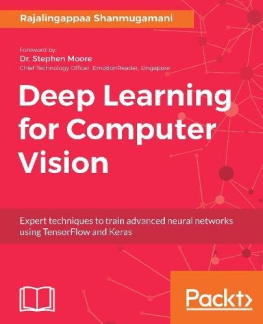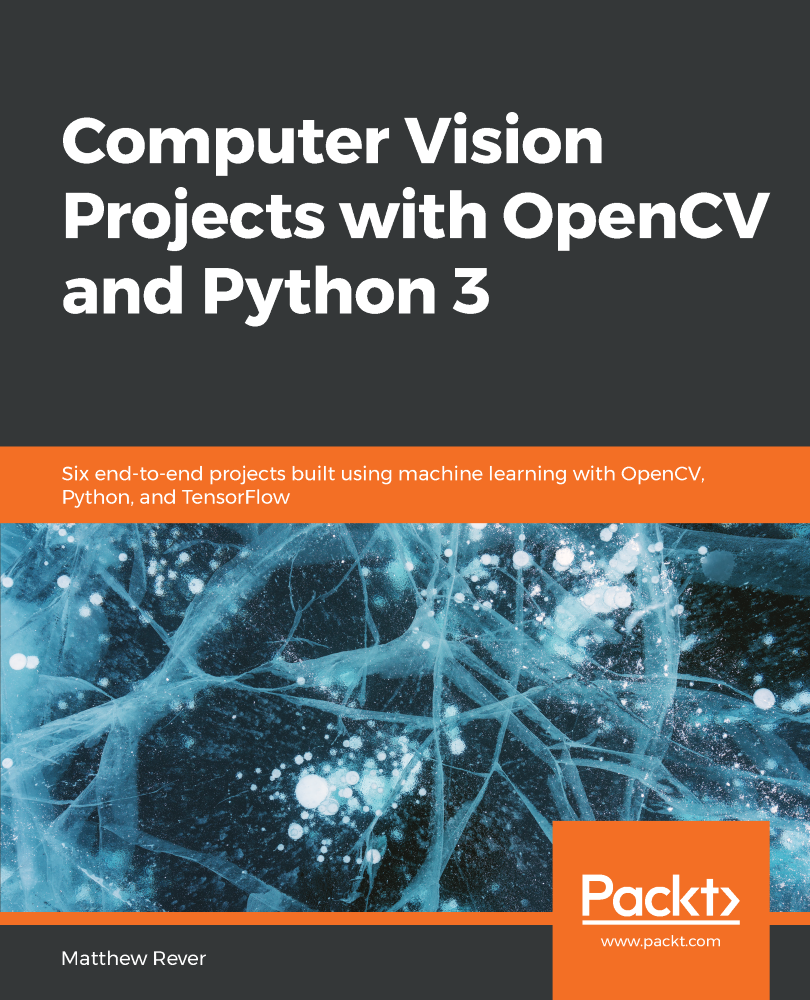Rever - Computer Vision Projects with OpenCV and Python 3
Here you can read online Rever - Computer Vision Projects with OpenCV and Python 3 full text of the book (entire story) in english for free. Download pdf and epub, get meaning, cover and reviews about this ebook. City: Birmingham;England, year: 2018, publisher: Packt Publishing, genre: Home and family. Description of the work, (preface) as well as reviews are available. Best literature library LitArk.com created for fans of good reading and offers a wide selection of genres:
Romance novel
Science fiction
Adventure
Detective
Science
History
Home and family
Prose
Art
Politics
Computer
Non-fiction
Religion
Business
Children
Humor
Choose a favorite category and find really read worthwhile books. Enjoy immersion in the world of imagination, feel the emotions of the characters or learn something new for yourself, make an fascinating discovery.

- Book:Computer Vision Projects with OpenCV and Python 3
- Author:
- Publisher:Packt Publishing
- Genre:
- Year:2018
- City:Birmingham;England
- Rating:5 / 5
- Favourites:Add to favourites
- Your mark:
Computer Vision Projects with OpenCV and Python 3: summary, description and annotation
We offer to read an annotation, description, summary or preface (depends on what the author of the book "Computer Vision Projects with OpenCV and Python 3" wrote himself). If you haven't found the necessary information about the book — write in the comments, we will try to find it.
Gain a working knowledge of advanced machine learning and explore Pythons powerful tools for extracting data from images and videos
Key Features- Implement image classification and object detection using machine learning and deep learning
- Perform image classification, object detection, image segmentation, and other Computer Vision tasks
- Crisp content with a practical approach to solving real-world problems in Computer Vision
Python is the ideal programming language for rapidly prototyping and developing production-grade codes for image processing and Computer Vision with its robust syntax and wealth of powerful libraries. This book will help you design and develop production-grade Computer Vision projects tackling real-world problems.
With the help of this book, you will learn how to set up Anaconda and Python for the major OSes with cutting-edge third-party libraries for Computer Vision. Youll learn state-of-the-art techniques for classifying images, finding and identifying human postures, and detecting faces within videos. You will use powerful machine learning tools such as OpenCV, Dlib, and TensorFlow to build exciting projects such as classifying handwritten digits, detecting facial features,and much more. The book also covers some advanced projects, such as reading text from license plates from real-world images using Googles Tesseract software, and tracking human body poses using DeeperCut within TensorFlow.
By the end of this book, you will have the expertise required to build your own Computer Vision projects using Python and its associated libraries.
What you will learn- Install and run major Computer Vision packages within Python
- Apply powerful support vector machines for simple digit classification
- Understand deep learning with TensorFlow
- Build a deep learning classifier for general images
- Use LSTMs for automated image captioning
- Read text from real-world images
- Extract human pose data from images
Python programmers and machine learning developers who wish to build exciting Computer Vision projects using the power of machine learning and OpenCV will find this book useful. The only prerequisite for this book is that you should have a sound knowledge of Python programming.
Downloading the example code for this book You can download the example code files for all Packt books you have purchased from your account at http://www.PacktPub.com. If you purchased this book elsewhere, you can visit http://www.PacktPub.com/support and register to have the files e-mailed directly to you.
Rever: author's other books
Who wrote Computer Vision Projects with OpenCV and Python 3? Find out the surname, the name of the author of the book and a list of all author's works by series.







